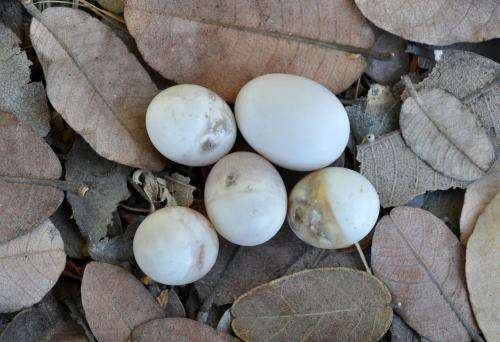Honeyguide birds destroy own species' eggs to eliminate competition

Like cuckoos, honeyguides are parasitic birds that lay their eggs in other birds' nests and dupe them into raising their young. Now scientists reveal that, unlike in cuckoos, the resemblance between honeyguide eggs and those of their bee-eater bird hosts hasn't evolved to trick hosts into accepting the imposter egg as one of their own. Rather, it appears to have evolved to trick other honeyguides who would otherwise destroy the eggs because of fierce competition for host nests. The new research is published today, 21 August, in the journal Biology Letters.
Honeyguides are intriguingly odd birds that are best-known for their unique, mutually beneficial relationship with humans. Honeyguides love to eat beeswax. To obtain it, they guide human honey-hunters to bees' nests. In return for showing the humans the bees, the honeyguide gains access to the otherwise dangerous and impenetrable nest and its sought-after wax.
But these African birds also have a dark side. They are unusually vicious parasites whose imposter chicks stab the chicks of their host birds (often little bee-eaters) to death as soon as they hatch in order to eliminate competition for the host parents' care. The newly published research has shown that this fight for monopoly of the nest also extends to other honeyguides in a battle conducted deep underground in the nest burrows that bee-eaters dig into the roofs of Aardvark holes.
The researchers' curiosity was piqued by their earlier finding that like cuckoo eggs, honeyguide eggs resemble those of each of their several host species. Instead of mimicking their colour, however, they mimic their size (as colour is irrelevant in the dark interior of the deep holes in which hosts breed). For example, honeyguides parasitising little bee-eaters lay smaller eggs in their nests than do honeyguides parasitising larger hosts. Many classic studies have shown that comparable mimicry in cuckoo eggs has evolved to reduce rejection by choosy hosts that eject mismatched eggs from their nests.
Dr Claire Spottiswoode from the University of Cambridge's Department of Zoology, who carried out the research, said: "I assumed honeyguide egg mimicry had evolved just like cuckoo mimicry, so was bowled over and baffled when little bee-eaters turned out to be pretty dim. When I played the honeyguide and experimentally parasitised their nests, the bee-eaters blithely incubated eggs even much larger than their own. So I was quite wrong, and mimicry probably hasn't evolved to dupe bee-eaters.
"It was only when some of my experiments were parasitised by real honeyguides, and my experimental eggs were pecked to pieces, that the penny dropped – perhaps they need to look like bee-eaters or else other honeyguides will get rid of them, to avoid suffering the same grisly fate that they impose upon their hosts."
A second experiment supported this hypothesis: again the researchers placed a larger foreign egg in bee-eaters nests, but then waited for a real honeyguide to come along and lay her own egg. When this happened they counted the number of puncture holes the female honeyguide made in each egg in the clutch. This revealed that laying honeyguides punctured the larger foreign egg more heavily than host eggs, lest it be another honeyguide's egg and kill their own chick should it hatch first. Evolution should then favour honeyguide females that lay eggs resembling those of bee-eaters and thereby avoid being detected and destroyed by a competing honeyguide.
The suggestion that mimicry might evolve because parasites benefit from concealing their eggs from one another was first made by Cambridge scientists Nick Davies and Michael Brooke 25 years ago, but this study is the first to show that it probably happens in the wild. Honeyguide parasitism on little bee-eaters is very common and about a third of parasitised nests contain eggs laid by two or more honeyguide females, resulting in especially strong parasitic competition.
Dr Spottiswoode said: "Under these circumstances it makes good sense that honeyguides have a lot to gain from tricking other honeyguides. But we still don't know why bee-eaters parents themselves are so undiscriminating, especially when they pay such high costs of being conned – all your offspring hacked to death, and over a month wasted raising the wrong chick!"
The research was funded by The Royal Society and the DST/NRF Centre of Excellence at Percy FitzPatrick Institute, University of Cape Town. It forms part of a wider research programme investigating coevolution between parasitic birds and their hosts in Zambia led by Dr Claire Spottiswoode, who adds "My colleagues and I are very lucky to be helped by a wonderful team of local field assistants who find all the nests we study, and in this case dug many holes into rock-hard soil to reach bee-eater nests and carry out these experiments!"
More information: The paper 'A brood parasite selects for its own egg traits' will be published in the 21 August edition of Biology Letters: rsbl.royalsocietypublishing.or … .1098/rsbl.2013.0573
Journal information: Biology Letters
Provided by University of Cambridge



















